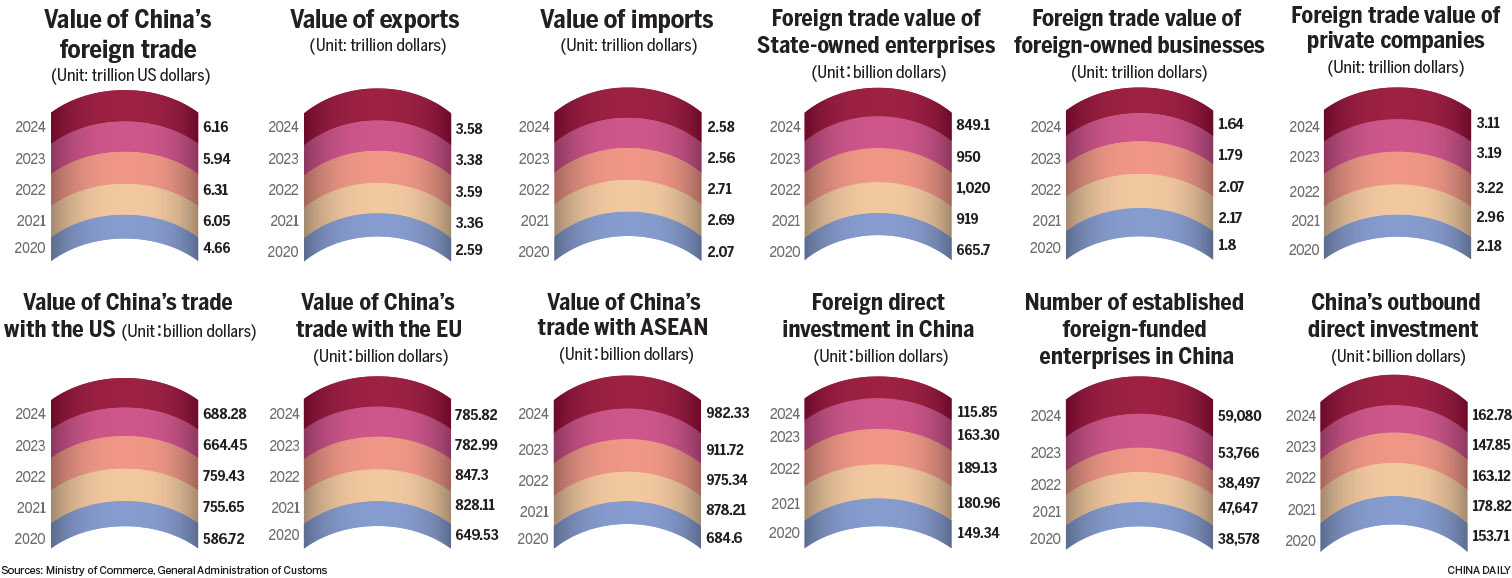Nation moves to technology-intensive, globally integrated model amid challenges

During the early years of the 14th Five-Year Plan (2021-25) period, running a manufacturing business was easy for many factory owners in China.
Orders poured in from clients in Frankfurt, Osaka, Melbourne, Detroit, Sao Paulo and Nairobi. Factories hummed day and night, turning out laptops, garments, ventilators and industrial equipment to be shipped across oceans.
Even amid the COVID-19 pandemic, China's foreign trade surged 21.4 percent year-on-year to 39.1 trillion yuan ($5.49 trillion) in 2021, according to the General Administration of Customs, or GAC.
Today, that pattern has been transformed. The old processing-based trade model has been replaced by a far more sophisticated, technology-intensive and globally integrated landscape — one that reflects China's transformation from the world's workshop into a key driver of innovation and trade amid rising geopolitical uncertainties and shifting global supply chains.
READ MORE: China to further enhance policies, new steps to stabilize foreign trade
During the 14th Five-Year Plan period, China advanced high-level opening-up on all fronts. The country expanded its pilot free trade zones and promoted steady implementation of the Regional Comprehensive Economic Partnership, the world's largest free trade pact in terms of GDP and population, said Commerce Minister Wang Wentao.
Wang said China will intensify efforts to advance high-quality trade development, deepen international cooperation and bolster innovation to further boost exports during the next five-year plan period.
As these efforts take effect, China's export structure is also shifting toward greater sophistication.
Lyu Daliang, director of the GAC's department of statistics and analysis, said Chinese businesses have also moved up the value chain, creating new competitive edges in electric passenger vehicles, lithium batteries and solar cells — dubbed the "new trio" of Chinese exports.
Together with the fast-growing artificial intelligence, semiconductor, robotics and innovative drugs sectors, these industries are symbols of China's industrial upgrading and green transition, he added.
Innovation transformation
This transformation is evident on the factory floor.
Jiangsu Tianhong Machinery Industrial Co, a Danyang, Jiangsu province-based industrial equipment manufacturer, launched a new generation of intelligent aluminum alloy melting equipment during the 14th Five-Year Plan period.
"Our new product reduces energy consumption while improving melting speed and purity," said Tang Jianjun, head of the company's foreign trade unit, adding his company will continue to strengthen industrial R&D and strive for new breakthroughs in aluminum alloy casting and related fields during the next five-year plan period.
In the first eight months of 2025, Jiangsu Tianhong's export value exceeded 50 million yuan, up 11.1 percent year-on-year, data from Nanjing Customs showed.
"We will expand our global footprint by establishing innovation and sales centers in Europe, Southeast Asia and Mexico, aiming to raise the share of foreign trade in our total sales to 60 percent between 2026 and 2030," said Tang.
About 1,400 kilometers from Danyang, workers at Guangdong Greenway Technology Co, a lithium battery manufacturer based in Dongguan, Guangdong province, are busy loading shipping containers with lithium batteries of various shapes and sizes destined for the port of Rotterdam in the Netherlands.
"To meet different climate conditions and user needs around the world, we have developed two main battery solutions," said Wu Jing, head of the company's foreign trade unit.
One is designed for cold regions, it can be charged at temperatures as low as — 10 C and still work at — 20 C, solving a major challenge for users in chilly environments.
The other is built for hot climates, able to operate steadily even at around 40 C. This version has become the first battery choice in many tropical regions in Southeast Asia and Africa, powering electric scooters, cleaning robots and portable energy storage systems that serve both daily life and industry.
Wu said that constant innovation is essential for Chinese manufacturers to stay competitive in the global market and avoid being left behind.
Guangdong Greenway saw its exports jump 65 percent on a yearly basis to 576 million yuan in the first half of the year, according to Huangpu Customs in Guangdong.

Agile supply chains
Despite global trade uncertainties and geopolitical challenges, trade experts said that China's foreign trade, backed by well-developed supply chains and opening-up policies, will gain further momentum over the long term as manufacturers shift toward more technology-intensive exports and strengthen ties with emerging markets.
China's foreign trade production and supply chains have grown more complete, agile and efficient, strengthening the nation's capacity to withstand external uncertainties and providing a solid foundation for sustained, high-quality trade growth, said Ying Pinguang, dean of Shanghai University of International Business and Economics' School of Global Governance.
Rising orders from Europe, economies participating in the Belt and Road Initiative and other emerging markets are fueling new growth engines for Chinese manufacturers, while accelerating the upgrade of China's export structure and strengthening its trade ties with major global partners, said Wan Zhe, a professor specializing in regional economic development at Beijing Normal University.
According to the latest data released by the GAC, China's foreign trade grew 4 percent year-on-year to 33.61 trillion yuan in the first three quarters of 2025.
Exports rose 7.1 percent year-on-year to 19.95 trillion yuan between January and September, while imports dipped 0.2 percent to 13.66 trillion yuan during the same period.
Meanwhile, China's trade with the Association of Southeast Asian Nations, Latin America, Africa and Central Asia rose 9.6 percent, 3.9 percent, 19.5 percent and 16.7 percent year-on-year, respectively. Trade with economies participating in the Belt and Road Initiative also climbed 6.2 percent year-on-year, accounting for 51.7 percent of China's total imports and exports — up 1.1 percentage points from a year earlier.
As economic globalization faces mounting challenges and unilateralism and protectionism continue to rise, China International Trade Representative Li Chenggang said the global economic order and governance system have come under growing strain.
In response, China has reaffirmed its commitment to the multilateral trading system and worked to expand its network of high-standard free trade agreements, advancing multilateral and regional cooperation in tandem, said Li, who is also vice-minister of commerce.
Regional focus
China and ASEAN are advancing their respective domestic ratification procedures to push for the formal signing of China-ASEAN Free Trade Area 3.0 by the end of this year.
Economic ties between China and ASEAN are expected to not only expand in scale but also improve in quality, Pov Somnang, special assistant to the ASEAN secretary-general.
He said the upgraded free trade agreement will lower tariffs on goods, widen market access for services and harmonize rules on intellectual property, environmental standards and digital trade, creating a more stable and open business environment for both sides.
As regional trade liberalization deepens, many Chinese manufacturers are seizing new opportunities to expand their overseas presence and upgrade their production through innovation and digitalization.
ALSO READ: Financial sector mobilizes to support high-quality growth
One of them is Ningbo Jingwei Systemtechnik Ltd, a manufacturer of printing, packaging and garment cutting equipment in Ningbo, Zhejiang province. The company began to accelerate the establishment of a global service network in 2021. It has set up after-sales service centers in Southeast Asia and Europe, cutting average maintenance response time by 50 percent and achieving localized operations.
Leveraging cross-border e-commerce, Ningbo Jingwei has directly reached overseas end customers and expanded its global presence. According to Ningbo Customs, the company's export value exceeded 110 million yuan in the first nine months of the year, growing 7 percent on a yearly basis.
"Looking ahead to the next five-year plan period, we will focus on deeper integration between artificial intelligence and intelligent cutting equipment to enhance autonomous learning and adaptive capabilities," said Zheng Zhaoze, the company's vice-president.
"We also plan to further expand our global footprint by setting up comprehensive service stations in more countries and regions, especially in emerging markets, shortening average maintenance response time even further, so that customers worldwide can enjoy faster and more personalized local services," said Zheng.
Contact the writers at zhongnan@chinadaily.com.cn


